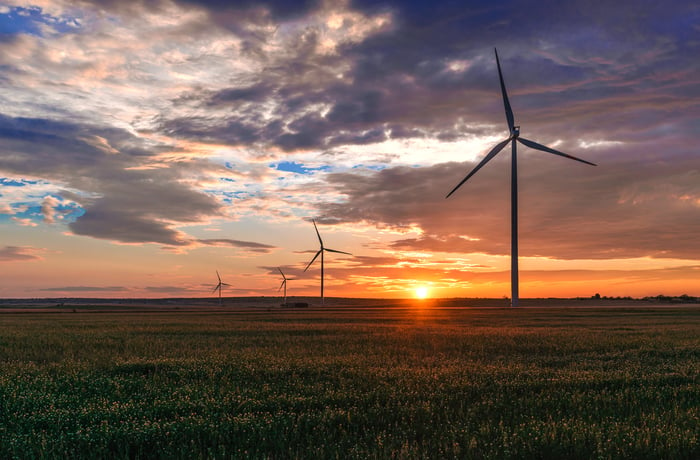This year has been a fantastic one for renewable energy stocks. The Invesco Solar ETF, which focuses on solar energy stocks, is up a stunning 192% this year. Meanwhile, the iShares Global Clean Energy ETF has surged an impressive 110%. That's despite some impact from the COVID-19 outbreak on the sector, which slowed project development.
However, as good as 2020 has been for renewables, the future is even brighter. Here are two reasons investors should consider investing in renewable energy stocks even after a big run in 2020.

Image source: Getty Images.
The sector's growth prospects are simply breathtaking
The cost of renewable energy developments has declined to the point where they're becoming cheaper than fossil fuels. Onshore wind is less expensive in many areas than building a new combined cycle gas turbine, while solar is rapidly reaching that point. Many forecasters believe that solar will soon be the lowest cost supplier of bulk power.
Because of that, and growing climate change concerns -- which is powering net-zero pledges around the globe -- renewable energy development is accelerating. According to the National Renewable Energy Laboratory, the sector is on track to add an average of 10 gigawatts (GW) of new solar and a similar amount of new wind capacity per year through 2022. Forecasters see a brisker pace in the 2023 to 2030 timeframe of 12-15 GW of wind and 18-20 GW of solar, implying 15% average annual market growth. As a result, the companies focused on the sector should grow at accelerating rates over the next several years.
Meanwhile, the longer-term opportunity is even greater as companies and governments race to meet their pledges of a net-zero carbon future by 2050. One potential power source that could fuel an enormous increase in renewable energy usage is green hydrogen. That emissions-free fuel has the potential to grow the addressable market for renewable energy by 19 to 24 times its current size by 2050.
The returns from renewable are increasingly attractive
For years, the main driver of renewable energy development was government incentives, which were necessary to justify the investment. However, with costs coming down so dramatically, renewables can generate attractive returns on investment.
Brookfield Renewable (BEP) (BEPC -0.09%) wrote about that in its second-quarter shareholder letter. The company is most enthusiastic about solar. It pointed out that:
As a result of technology advances and reductions in construction costs, solar can stand on its own without subsidies and more importantly, is now among the lowest cost sources of conventional power globally. To put this in perspective, solar costs over the last five years-the period in which we have built our solar business-have gone from over $4 per watt to install, to less than a $1 per watt in almost all jurisdictions around the world. As a result of these favorable economics, as well as the renewable nature and perpetual source of free energy, we believe it is possible that in ten years from now the majority of the production capacity of Brookfield Renewable will be solar capacity. It is not that we do not believe in wind or hydro but the growth in solar and the ability for us to develop and earn strong risk adjusted returns should enable us to grow our solar operations at a far greater pace.
The company put the returns into context by discussing a recent investment. It acquired a 1.2 GW solar development project in Brazil for $200 million, which is one of the largest solar development projects in the world. Brookfield noted that, thanks to its: "global scale, we expect to drive down equipment procurement, installation and operating costs to deliver additional value over time. Accordingly, we expect to achieve approximately 20% returns on this investment."
High-return projects like that are powering Brookfield's forecast that it can grow its cash flow per share at an 11% to 16% annual clip through 2025. That would support 5% to 9% annual increases to its dividend. Meanwhile, leading renewable energy generator NextEra Energy (NEE 0.54%) also sees high-powered growth ahead. The utility recently raised and extended its earnings growth outlook, forecasting 6% to 8% annual earnings-per-share growth through 2023 off of a 10% higher baseline for 2021. That renewable-powered forecast should enable NextEra to grow its dividend by around 10% annually through at least 2022. This high-powered growth should give these renewable-focused companies the power to generate market-beating total returns.
Growth that matters
The renewable energy industry has a spotty track record of creating value for investors because many companies chased growth at all costs. However, with development costs coming down, renewables are increasingly profitable investments. The sector thus appears poised to pay big dividends for investors in the company years, especially as value creators like Brookfield and NextEra accelerate their development capabilities to capture more of the growth ahead in the sector.





